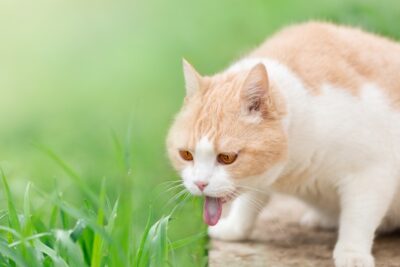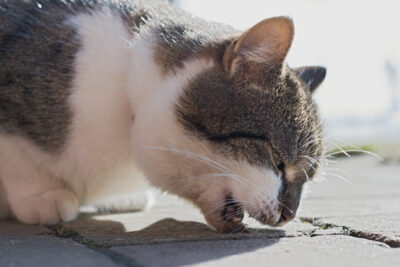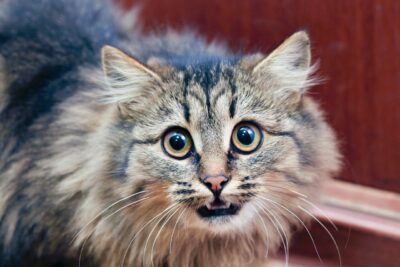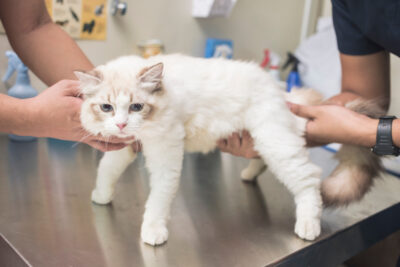Why Is My Cat Losing Hair? Causes and How to Help
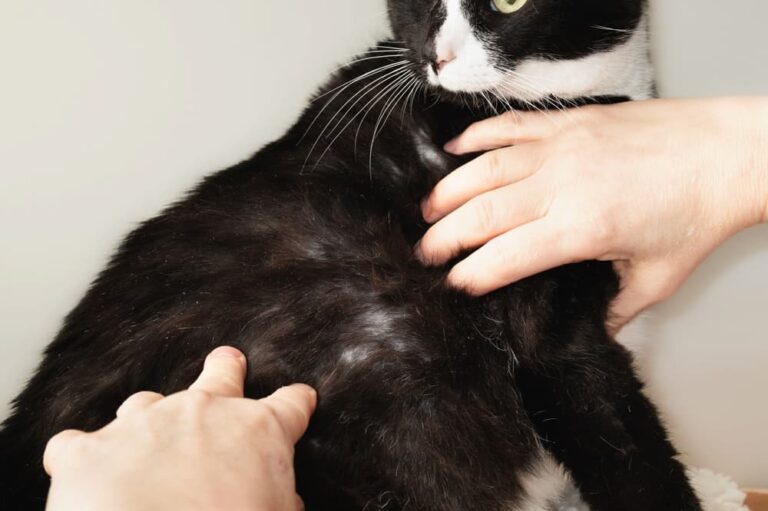
All featured products are chosen at the discretion of the GreatPetCare editorial team and do not reflect a direct endorsement by the author or reviewer.
It’s natural for cats to shed fur. We all want a cat who doesn’t leave fur around the house, but their fur grows and then it sheds. Some cats, however, will lose so much fur that it starts to look thin and you can see their skin more clearly. Normal shedding of fur would not allow you to see the skin so easily. If you’re wondering “why is my cat losing hair,” we’re here to explain the most common causes. Some may even surprise you!
Is Your Cat Losing Fur? All About Alopecia in Cats
Cat fur, or hair, goes through various stages of natural growth and shedding. When it is growing, it is in the anagen phase, and the fur roots are round and larger. When fur is no longer growing, the root of the hair gets small, so it easily falls out — this is called the telogen phase.
Alopecia is when fur is lost that is not part of the normal growth cycle. When alopecia occurs, a bald spot or thin, patchy fur is noted anywhere on the cat’s body. Alopecia may expose skin underneath that looks pretty normal, or it can look very abnormal. Pet parents may notice that cat fur loss increases in certain times of year, making it seem seasonal. There is almost always a medical issue to explain this — it is rarely caused by cat behavioral problems.
There are many causes of alopecia in cats, and every cat is susceptible. Any age or breed of cat can be affected, although alopecia is more common in some breeds like Siamese. Cats of any lifestyle (indoor, outdoor, or both) can develop alopecia.
Types of Alopecia in Cats
There are a few descriptions of what kind of alopecia your cat is experiencing, which include:
- Patchy alopecia, when fur is thin in some places but normal length in other places in the same area of the body
- Generalized alopecia, when losing fur in large portions of the whole body
- Symmetrical alopecia, when losing fur on both sides of the body in a similar pattern
- Multifocal alopecia, when losing fur in multiple separate areas of the body
- Seasonal alopecia, when losing fur during specific seasons of the year (i.e., every spring, summer, and/or fall)
Sometimes, pet parents notice that their cat’s fur is being lost in very small clumps with very small scabs or crusts. This is known as miliary dermatitis in cats, and it is commonly seen around the head and neck of cats.
Symptoms of Alopecia in Cats
Sometimes, cats lose fur with no other apparent symptoms. However, other symptoms are common and may include:
- Frequent grooming and pulling/biting at the fur (note that this is normal behavior, but can seem exaggerated to some pet parents)
- Redness of the skin
- Crust of the skin — miliary crust (very small brown scabs), serous crust (an area of the skin has thin yellow-clear crust tightly adhered), bloody crust, yellow or green crust
- Scaly skin
- Comedones (“blackheads”), very small black spots on the skin
- Greasy skin or fur
- Scratches or mild bleeding of the skin
Why Is My Cat Losing Hair? 10 Possible Reasons
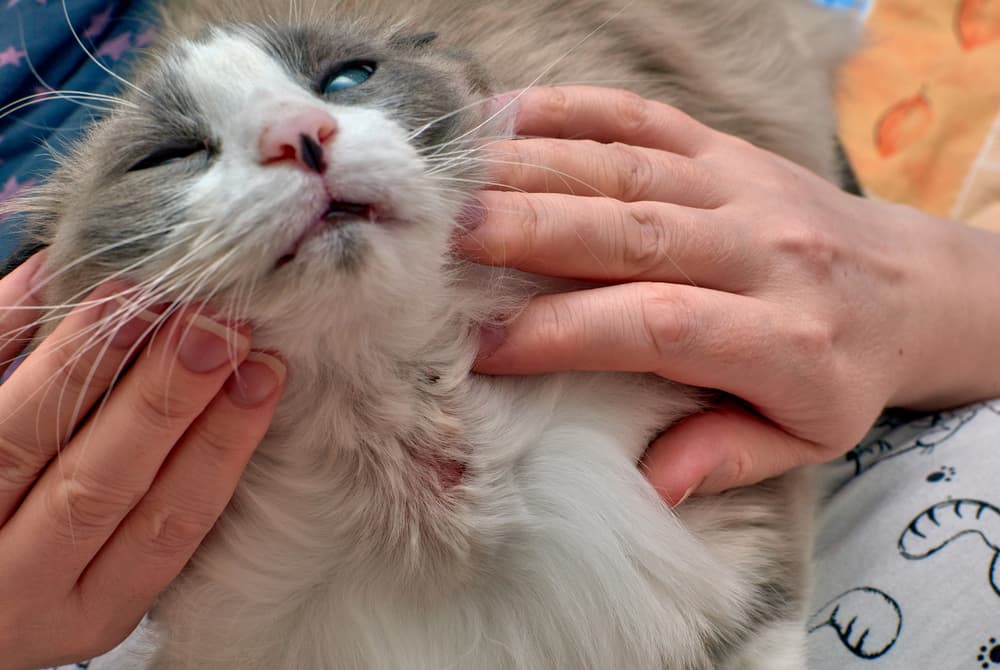
The most common reason by far for your cat to lose their fur is allergies! There are three types of allergies listed below. Other than that, a variety of parasites or illnesses may be the cause:
Flea allergy
Even one bite from a flea can cause a big reaction, leading to itchiness.
Food allergy
Allergies to food cause a reaction in the skin, which leads to itchiness and inflammation.
Environmental allergies
Allergies can be to many different things — pollen, dust, mold — that lead to a skin reaction.
Mange like Demodex or Otodectes
Demodex mites live in the follicles of the fur (where the fur roots are). When a cat experiences illness that decreases their immune system, these mites overpopulate the skin and cause inflammation of the hair follicles themselves. This disrupts the fur’s normal growth cycle, causing fur to fall out. Otodectes are ear mites and cause intense itchiness. Cats scratch around their ears furiously, causing fur to fall out.
Ringworm (dermatophytosis)
Ringworm is a fungal infection of the skin, causing inflammation of the follicles that hold fur. When the skin is inflamed, the fur falls out. Sometimes, cats are itchy with this infection.
Pain like arthritis or bladder inflammation (cystitis)
Cats with arthritis may overgroom the area that is near the source of pain. Cats with cystitis may overgroom the area of the lower belly in between the back legs.
Hyperthyroidism
Around 10 percent of cats over the age of 9 develop an overactive thyroid gland. This can cause changes in the skin, but alopecia is uncommon in cats with this condition (only around 3 percent of hyperthyroid cats).
Cancer
This is a rare cause of alopecia. Cancer found inside of your cat can cause alopecia, such as a thymoma.
Follicular dysplasia
Caused by genetics, this condition causes the follicles of the fur to be abnormal. Cornish Rex cats are prone to this. Sphynx and Lykoi cats are intentionally bred with this condition to create a specific kind of fur coat.
Psychogenic alopecia (behavioral causes)
This is rare, as most alopecia is due to medical problems. Your veterinarian has to rule out all medical causes to consider this. Usually, cats begin to overgroom themselves due to a stressful event such as adding a new pet to the family or moving.
Cat Hair Loss by Area of the Body
While the location of fur loss cannot diagnose the reason behind your cat’s alopecia, there are some more common reasons why fur is lost in specific areas of the body. Where is your cat losing hair?
- Ears? Ear mites, ringworm
- Head/face? Allergies, fleas, ringworm, mange
- Back/sides? Allergies, pain, hyperthyroidism, psychogenic alopecia
- Belly/stomach? Allergies, pain (especially cystitis)
- All legs? Mange, psychogenic alopecia
- Front legs? Psychogenic alopecia
- Back legs? Allergies, pain
- Back near tail? Fleas, allergies, pain
- Tail? Ringworm, allergies
Diagnosing the Cause of Cat Hair Loss

Your veterinarian will perform a thorough examination of your cat, taking note of all lesions on the body and the location of the fur loss. They will also look for evidence of fleas, although live fleas can be hard to spot since cats are excellent groomers. Most of the time, bloodwork and a urinalysis will be performed to look for underlying medical conditions, particularly if your cat is not very young. X-rays may help look for arthritis, stones in the bladder, or other conditions.
There are several tests that examine the skin specifically:
- Skin scrape. Using a very small blade, the very top layer of the skin is carefully scraped away to look for mites.
- Trichogram. Fur is plucked to look for mites and ringworm, and to ensure the roots of the fur appear normal.
- Cytology. This is most useful for the ears. A swab of debris from inside the ears can identify ear mite infestations. Cytology of the skin can look for bacterial or yeast infections, but these are not the root cause.
- Wood’s lamp. A specific UV light is used to examine for possible ringworm.
- Fungal culture. A swab of your kitty’s fur is used to try and grow ringworm on a culture plate. This test can take up to two weeks.
- Biopsy. Your veterinarian would anesthetize your pet and surgically remove a very small piece of skin from the area that is affected. This is typically recommended with really severe skin conditions or ones that do not improve with therapy.
There is no good way to test for food allergies. The blood tests are not very accurate, so oftentimes a food trial is necessary to diagnose this. (You can read more about food trials under treatment.) Environmental allergies are very time intensive to test for and typically require the work of a dermatologist for testing (specialist for skin conditions).
Treatment for Hair Loss in Cats
The treatment of the alopecia involves treating the underlying condition itself:
Flea allergy. Flea treatment/preventives year-round
Food allergy. Food trial. The most common food allergens for cats are beef, fish, chicken and dairy products. Pet parents should purchase a food that has none of these proteins in them or any other proteins their cat has eaten before, and feed only that flavor of food to their cat with no other treats, people food, or other flavors of cat food for at least two months. If the symptoms start going away, food allergy is likely.
Environmental allergies. Anti-inflammatory medications for allergies such as antihistamines, steroids, or a variety of immunosuppressive medications
Mange like Demodex or Otodectes. Specific types of flea preventives treat mange, depending on what kind of mange your cat has
Ringworm (dermatophytosis). Anti-fungal shampoo and medication for ringworm
Pain like arthritis or bladder inflammation (cystitis). Pain medications
Hyperthyroidism. Methimazole, a medication that decreases thyroid hormone
Psychogenic alopecia (behavioral causes). Increased environmental enrichment and other modifications of the environment, typically along with behavioral medications



Holistic Remedies
There are a couple possibilities for home treatment for hair loss in cats. Omega-3 fatty acid supplements support joint, coat, and skin health. If food allergies are suspected, fish oil is not recommended, but flaxseed oil could be used instead. Diet is important — cut out all treats, people food, or other cat foods from your cat’s diet. The best cat food for a cat losing hair would be a diet without the common food allergens and feeding only that to your cat.


How to Prevent Hair Loss in Cats
Using a prescription flea control product year round is a good first step to help avoid a cat losing hair. In addition, don’t allow your cat to interact with other cats if you are unsure of their health status. The moment you notice differences in your cat’s behavior, it is important to bring them to the veterinarian. This way, any new conditions can be treated quickly to help prevent hair loss in cats.
